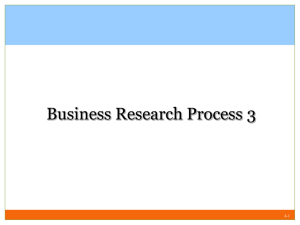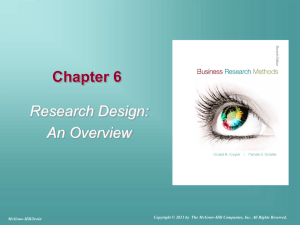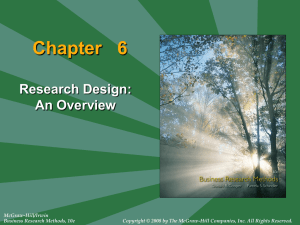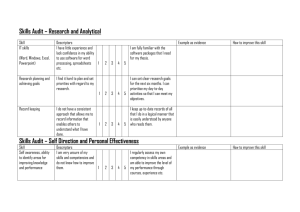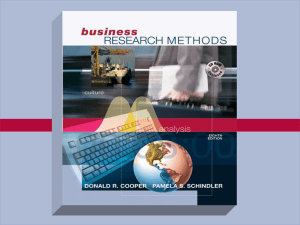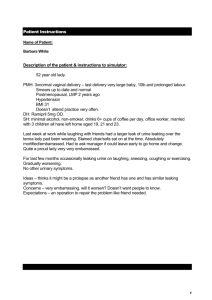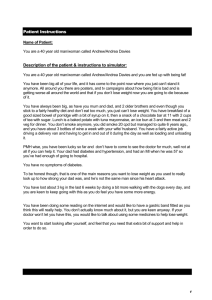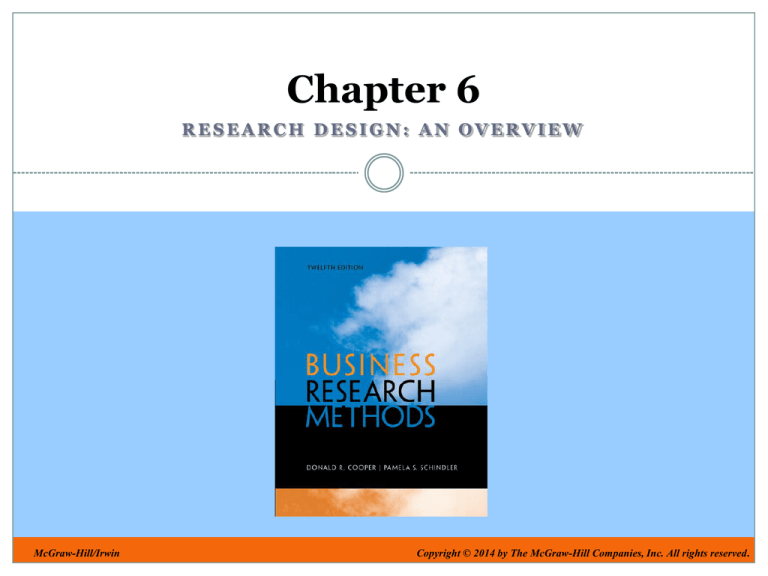
Chapter 6
RESEARCH DESIGN: AN OVERVIEW
McGraw-Hill/Irwin
Copyright © 2014 by The McGraw-Hill Companies, Inc. All rights reserved.
Learning Objectives
Understand . . .
The basic stages of research design.
The major descriptors of research design.
The major types of research designs.
The relationships that exist between variables in
research design and the steps for evaluating
those relationships.
6-2
Research Thought Leaders
“We can forecast advances in technology,
but we can’t really forecast human reactions
to those advances. Maybe corporate
researchers will invest in big data analytics
only to discover they’re missing a hugely
important piece: the story of why.”
Ron Sellers, CEO,
GreyMatter Research & Consulting
6-3
What Is Research Design?
Blueprint
Plan
Guide
Framework
6-4
Design in the Research Process
6-5
What Tools Are Used in Designing
Research?
6-6
What Tools Are Used in Designing
Research?
MindWriter
Project Plan
in Gantt chart
format
6-7
Research Design Descriptors
Perceptual
Awareness
Purpose of
Study
Question
Crystallization
Descriptors
Data
Collection
Method
Experimental
Effects
Time
Dimension
Research
Environment
Topical Scope
6-8
Degree of
Question Crystallization
Exploratory Study
Formal Study
Loose structure
Precise procedures
Expand
understanding
Provide insight
Develop hypotheses
Begins with
hypotheses
Answers research
questions
6-9
Approaches for Exploratory
Investigations
Participant observation
Film, photographs
Projective techniques
Psychological testing
Case studies
Ethnography
Expert interviews
Document analysis
Proxemics and Kinesics
6-10
Desired Outcomes of
Exploratory Studies
Established range and scope of possible
management decisions
Established major dimensions of
research task
Defined a set of subsidiary questions
that can guide research design
6-11
Desired Outcomes of
Exploratory Studies (cont.)
Develop hypotheses about possible
causes of management dilemma
Learn which hypotheses
can be safely ignored
Conclude additional research is
not needed or not feasible
6-12
Commonly Used Exploratory Techniques
Secondary
Data Analysis
Experience
Surveys
Focus
Groups
6-13
Face-to-face
interaction—
one of the best
ways to learn
from
participants.
6-14
Experience Surveys
What is being done?
What has been tried in the past with or
without success?
How have things changed?
Who is involved in the decisions?
What problem areas can be seen?
Whom can we count on to assist or
participate in the research?
6-15
Focus Groups
Group discussion
6-10 participants
Moderator-led
90 minutes-2
hours
6-16
Research Design Descriptors
Perceptual
Awareness
Purpose of
Study
Question
Crystallization
Descriptors
Data
Collection
Method
Experimental
Effects
Time
Dimension
Research
Environment
Topical Scope
6-17
Data Collection Method
Communication
Monitoring
6-18
Research Design Descriptors
Perceptual
Awareness
Purpose of
Study
Question
Crystallization
Descriptors
Data
Collection
Method
Experimental
Effects
Time
Dimension
Research
Environment
Topical Scope
6-19
The Time Dimension
Cross-sectional
Longitudinal
6-20
Research Design Descriptors
Perceptual
Awareness
Purpose of
Study
Question
Crystallization
Descriptors
Data
Collection
Method
Experimental
Effects
Time
Dimension
Research
Environment
Topical Scope
6-21
The Topical Scope
Statistical Study
Breadth
Population
inferences
Quantitative
Generalizable
findings
Case Study
Depth
Detail
Qualitative
Multiple sources of
information
6-22
Research Design Descriptors
Perceptual
Awareness
Purpose of
Study
Question
Crystallization
Descriptors
Data
Collection
Method
Experimental
Effects
Time
Dimension
Research
Environment
Topical Scope
6-23
The Research Environment
Field conditions
Lab conditions
Simulations
6-24
Research Design Descriptors
Perceptual
Awareness
Purpose of
Study
Question
Crystallization
Descriptors
Data
Collection
Method
Experimental
Effects
Time
Dimension
Research
Environment
Topical Scope
6-25
Purpose of the Study
Reporting
Casual Explanatory
Descriptive
Causal Predictive
6-26
Descriptive Studies
Who?
How much?
What?
When?
Where?
6-27
Descriptive Studies
Descriptions of population
characteristics
Estimates of frequency of
characteristics
Discovery of associations
among variables
6-28
Research Design Descriptors
Perceptual
Awareness
Purpose of
Study
Question
Crystallization
Descriptors
Data
Collection
Method
Experimental
Effects
Time
Dimension
Research
Environment
Topical Scope
6-29
Experimental Effects
Ex Post Facto Study
Experiment
After-the-fact report
Study involving the
on what happened to
the measured
variable
manipulation or
control of one or
more variables to
determine the effect
on another variable
6-30
Ex Post Facto Design
Fishing Club Member
Non-Fishing-Club Member
Age
High
Absentee
Low Absentee
High
Absentee
Low Absentee
Under 30 years
36
6
30
48
30 to 45
4
4
35
117
45 and over
0
0
5
115
6-31
Causation and Experimental Design
Control/
Matching
Random
Assignment
6-32
Mills Method of Agreement
6-33
Mills Method of Difference
6-34
Causal Studies
Symmetrical
Reciprocal
Asymmetrical
6-35
Understanding Casual Relationships
Property
Behavior
Disposition
Response
Stimulus
6-36
Asymmetrical Casual Relationships
Stimulus-Response
PropertyDisposition
PropertyBehavior
Disposition-Behavior
6-37
Types of Asymmetrical Causal Relationships
Relationship
Type
Nature of
Relationship
Examples
Stimulusresponse
An event or change
results in a response
from some object.
• A change in work rules leads to a higher
level of worker output.
• A change in government economic policy
restricts corporate financial decisions.
• A price increase results in fewer unit sales.
Propertydisposition
An existing property
causes a disposition.
• Age and attitudes about saving.
• Gender attitudes toward social issues.
• Social class and opinions about taxation.
Dispositionbehavior
A disposition causes a
specific behavior.
• Opinions about a brand and its purchase.
• Job satisfaction and work output.
• Moral values and tax cheating.
An existing property
causes a specific
behavior.
• Stage of the family life cycle and
purchases of furniture.
• Social class and family savings patterns.
• Age and sports participation.
Property-behavior
6-38
Evidence
of
Causality
Covariation between A and B
Time order of events
No other possible causes of B
6-39
Research Design Descriptors
Perceptual
Awareness
Purpose of
Study
Question
Crystallization
Descriptors
Data
Collection
Method
Experimental
Effects
Time
Dimension
Research
Environment
Topical Scope
6-40
Participants’ Perceptional Awareness
No deviation perceived
Deviations perceived
as unrelated
Deviations perceived as
researcher-induced
6-41
Research Design Descriptors
Category
Options
The degree to which the research question has been
crystallized
• Exploratory study
• Formal study
The method of data collection
• Monitoring
• Communication Study
The power of the researcher to produce effects in the
variables under study
• Experimental
• Ex post facto
The purpose of the study
• Reporting
• Descriptive
• Causal-Explanatory
• Causal-Predictive
The time dimension
• Cross-sectional
• Longitudinal
The topical scope—breadth and depth—of the study
• Case
• Statistical study
The research environment
• Field setting
• Laboratory research
• Simulation
The participants’ perceptional awareness of the research
activity
• Actual routine
• Modified routine
6-42
Key Terms
Asymmetrical
relationship
Case study
Causal study
Causation
Children’s panels
Communication study
Control
Control group
Correlation
Cross-sectional study
Descriptive study
Ethnographic research
Ex post facto design
Experience
Experiment
Exploratory study
Field conditions
Focus group
Formal study
6-43
Key Terms (cont.)
Individual depth
interview
Intranet
Laboratory conditions
Longitudinal study
Matching
Monitoring
Primary data
Qualitative techniques
Random assignment
Reciprocal relationship
Research design
Secondary data
Simulation
Statistical study
Symmetrical relationship
6-44
Chapter 6
ADDITIONAL DISCUSSION OPPORTUNITIES
McGraw-Hill/Irwin
Copyright © 2014 by The McGraw-Hill Companies, Inc. All rights reserved.
Snapshot: McDonald’s Listening Tour
Products
Nutritional Messaging
Sustainability initiatives
6-46
Snapshot: Wildcat Surveys…Issues
Control Costs
Immediate Feedback
Sample Fatigue
Questioning expertise
Data Analysis Skills
6-47
Snapshot: Wildcat Survey…Researcher Role
Best practices, templates, and other
resources for self-executed projects
Reduce validity & redundancy
Become consultative partner
6-48
Research Thought Leaders
“Most human beings and most companies
don’t like to make choices. And they
particularly don’t like to make a few choices
that they really have to live with.”
Alan Lafley
former president and chairman of the board
P&G
6-49
PulsePoint: Research Revelation
76
The percent of mobile phone
subscribers worldwide who use SMS
text messaging.
6-50
Chapter 6
RESEARCH DESIGN: AN OVERVIEW
McGraw-Hill/Irwin
Copyright © 2014 by The McGraw-Hill Companies, Inc. All rights reserved.
Photo Attributions
Slide Source
4 Stockbyte/Getty Images
10 Pam McLean/Getty Images
26 John Lund/Annabelle Breakey/Blend Images/Punchstock
27 ©Daniel Koebe/Corbis
35 John Lund/Annabelle Breakey/Blend Images/Punchstock
36 John Lund/Annabelle Breakey/Blend Images/Punchstock
37 OJO Images/Getty Images
41 © Royalty-Free/Corbis
46 Stockbyte/Getty Images
47 ©Pamela S. Schindler
48 ©Pamela S. Schindler
6-52

